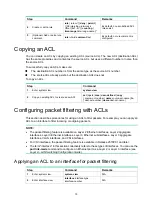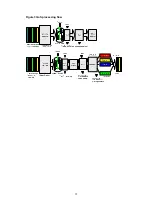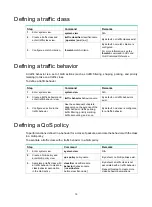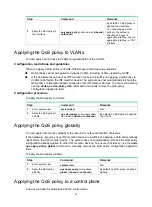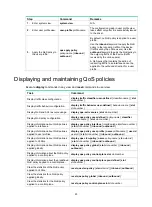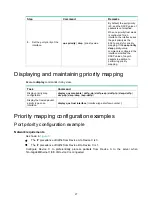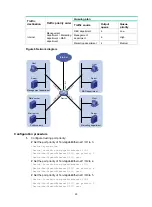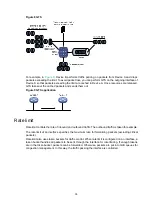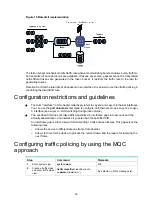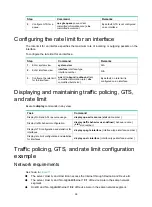
24
Configuring priority mapping
Both Layer 2 and Layer 3 Ethernet interfaces support priority mapping. The term "interface" in this
chapter collectively refers to these two types of interfaces. You can use the
port link-mode
command to configure an Ethernet port as a Layer 2 or Layer 3 interface (see
Layer 2—LAN
Switching Configuration Guide
).
Overview
When a packet arrives, a device assigns a set of QoS priority parameters to the packet based on
either of the following:
•
A priority field carried in the packet.
•
The port priority of the incoming port.
This process is called priority mapping. During this process, the device can modify the priority of the
packet according to the priority mapping rules. The set of QoS priority parameters decides the
scheduling priority and forwarding priority of the packet.
Priority mapping is implemented with priority maps and involves the following priorities:
•
802.1p priority.
•
DSCP.
•
EXP.
•
IP precedence.
•
Local precedence.
•
Drop priority.
Introduction to priorities
Priorities include the following types: priorities carried in packets, and priorities locally assigned for
scheduling only.
Packet-carried priorities include 802.1p priority, DSCP precedence, IP precedence, and EXP. These
priorities have global significance and affect the forwarding priority of packets across the network.
For more information about these priorities, see "
Locally assigned priorities only have local significance. They are assigned by the device only for
scheduling. These priorities include the local precedence, drop priority, and user priority, as follows:
•
Local
precedence
—Used for queuing. A local precedence value corresponds to an output
queue. A packet with higher local precedence is assigned to a higher priority output queue to be
preferentially scheduled.
•
Drop
priority
—Used for making packet drop decisions. Packets with the highest drop priority
are dropped preferentially.
Priority maps
The device provides various types of priority maps. By looking through a priority map, the device
decides which priority value to assign to a packet for subsequent packet processing.
The default priority maps (as shown in
Appendix B Default priority maps
) are available for priority
mapping. They are adequate in most cases. If a default priority map cannot meet your requirements,
you can modify the priority map as required.
Summary of Contents for FlexFabric 5940 Series
Page 23: ...17 Figure 3 QoS processing flow ...
Page 84: ...78 Figure 26 MPLS label structure ...
Page 91: ...85 Switch burst mode enable ...

